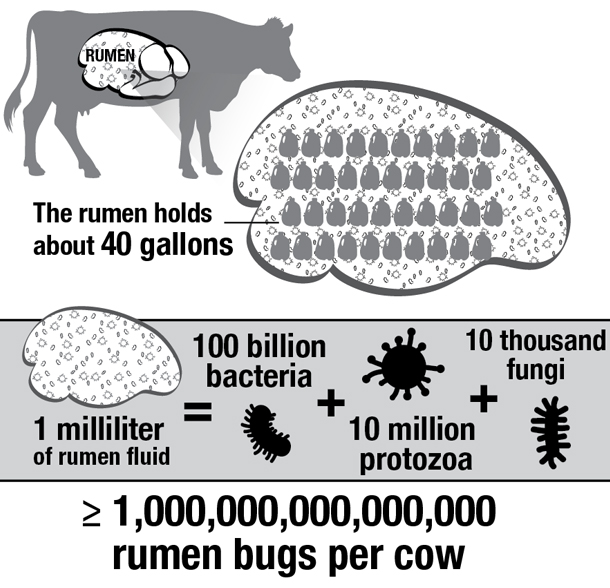These micro-organisms include protozoa, bacteria and fungi, and they live inside the rumen, one of the cow’s four stomachs.
-
Protozoa are the largest of the three rumen bugs and are almost large enough to see with the naked eye at 100 microns in length. If lined up end to end, 10 protozoa would be approximately a millimeter long – which is comparable to the thickness of a dime.
-
Bacteria are 100 times smaller than protozoa and are around 1 to 10 microns long.
-
Fungi are approximately 30 to 40 microns long. You might think of mold or mushrooms when you think of fungi. However, fungi in the rumen are entirely different. It turns out rumen fungi produce very powerful cellulolytic enzymes that play a major role in the breakdown of the fiber in grass and hay.
 In just 1 milliliter of rumen fluid you can find 100 billion bacteria, 10 million protozoa and 10,000 fungi. There are almost 5 milliliters in a teaspoon and 768 teaspoons in a gallon. If we consider the rumen holds approximately 40 gallons – we’re talking more than a quadrillion (1,000,000,000,000,000) rumen bugs per cow.
In just 1 milliliter of rumen fluid you can find 100 billion bacteria, 10 million protozoa and 10,000 fungi. There are almost 5 milliliters in a teaspoon and 768 teaspoons in a gallon. If we consider the rumen holds approximately 40 gallons – we’re talking more than a quadrillion (1,000,000,000,000,000) rumen bugs per cow.
What are the bugs doing?
Although you can’t see them, rumen bugs work together to break down what the cow eats, supplying energy and protein to the cow.
Rumen bugs produce volatile fatty acids – acetic, butyric and propionic – which cows use as an energy source. Rumen bugs also reproduce to create more of themselves – an important protein source.
When rumen microbes have reached the end of their life cycle, they are recycled and used by the cow. Rumen bugs are washed from the rumen to the lower gut and become a protein source for the cow.
What and how we feed cows affects which bugs grow, how feed is utilized and the nutrients available to the cow.
What can go wrong?
A lot can go wrong when it comes to rumen bugs. Sensitive to pH, a change in rumen pH can wipe out the entire population of rumen bugs fairly quickly.
If you feed an animal incorrectly – whether the nutrition itself (bad feed), the management of the nutrition (abrupt diet changes) or management of the animal (shipping cattle) – the pH of the rumen can decline, eliminating all three micro-organisms.
Bloat is a physical manifestation of rumen bugs gone wrong. Gas is a byproduct of rumen bugs breaking down feed, and when an animal cannot rid itself of the excess gas, bloat occurs.
Another sign of imbalanced rumen microbes is sub-acute rumen acidosis (SARA). Some bacteria produce lactic acid, and some bacteria utilize lactic acid.
When the population of bacteria gets out of balance and the lactic acid utilizers aren’t present, rumen acidosis starts to occur.
If the pH of the rumen gets below 5.4 and stays there, the microbe population in the rumen can become lactic acid producers. A build-up of lactic acid can paralyze muscles, including the diaphragm. As a result, the animal can stop breathing and die because of an imbalance in the rumen bug population.
Rumen pH is never constant – it goes down after each meal and starts to rise again when the animal chews its cud. The goal for rumen pH should be to stay at 5.9 or above 6.0. While it isn’t realistic to monitor rumen pH on a farm, there are management strategies you can implement to optimize rumen bug environment.
What can I do?
The primary goal should be to minimize any abrupt changes in the diet. Anything that causes an abrupt change in the animal’s diet can make things go awry quickly. Consuming multiple small meals throughout the day or “snack eating” can be beneficial to optimize rumen bug populations.
Feeding systems that stimulate cows to consume multiple small snacks of a feed supplement can optimize rumen health. Supplements with intake-control properties help send metabolic signals to the cow, saying that it’s time to stop eating the supplement and go graze.
After a day of small, snack-sized supplement portions, cattle don’t return famished to eat a “super-sized” portion – which can cause a broad shift in rumen pH and, ultimately, result in health challenges.
The whole science of nutrition is having a balanced diet and providing nutrients to the cow to keep rumen microbes from going bad.
If you think about it, you aren’t feeding your cows; you are feeding the rumen microbes inside the cow. And it’s our success or failure in feeding the rumen microbe population which impacts animal performance. ![]()
For more information, visit online (Purina Mills Cattle-Feed).

-
Hank Puch
- Manager, Large Animal Metabolism Unit
- Purina Animal Nutrition Center








